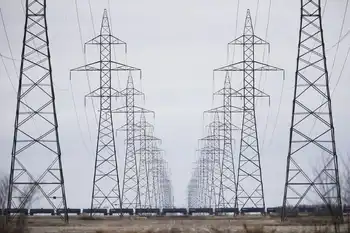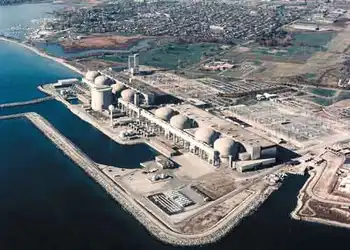A megawatt saved is a 'negawatt' earned
By Toronto Star
Arc Flash Training CSA Z462 - Electrical Safety Essentials
Our customized live online or in‑person group training can be delivered to your staff at your location.

- Live Online
- 6 hours Instructor-led
- Group Training Available
Aggregators help simplify an otherwise complex and often chaotic world, bringing together interesting content that time-constrained Internet users might enjoy but would likely never find by surfing the Net on their own. Aggregators don't sell content per se; they sell themed packages of content that some companies or individuals happily purchase.
Some might call it a value add – a role played by most middlemen – and we're beginning to see this approach emerge in the electricity sector. Only in this case aggregators aren't selling content. Their product is "negawatts" — the ability to reduce, on command, the electrical load on the power grid during a given time of need.
We saw negawatts in action when Loblaw Cos. turned off lights and cut back air conditioning in 110 of its largest grocery stores across the province. By reducing its overall electricity use by 20 per cent, the retail chain was able to take 10 megawatts of "load" off the grid – what you might call "negawatts."
A negawatt serves the same purpose as a megawatt, only it's better. A negawatt is a unit of power from a coal- or natural-gas-fired plant that is no longer needed. In this sense, a reduction in demand achieves the same goal as an equal increase in supply. The difference is there is no pollution or greenhouse gas emissions. No lost power as a result of long-distance transmission. No reliance on imports from the United States.
As part of a contract it signed with the province in 2005, Loblaw gets paid for a defined number of negawatts it can deliver during times of need. But the Ontario Power Authority, which oversees the contract, can't reasonably be expected to knock on the doors of every business, large and small, in an effort to strike similar deals.
That's where aggregators become vital to so-called demand-response programs, which are designed to lower electricity demand on the grid during typical consumption peaks. Aggregators exist to seek out organizations like Loblaw that are keen to conserve energy and make some money on the side.
South of the border, EnerNOC Inc., Comverge Inc. and Energyconnect Inc. are some of the larger demand-response aggregators that are busy building an inventory of negawatts.
Comverge, for example, has signed up hundreds of businesses and governments that have agreed to reduce their electricity demand within hours of notice. Collectively, these organizations can reliably lower their power consumption by 948 megawatts. That's two natural gas-fired plants that don't have to be built.
Similarly, EnerNOC has 796 megawatts of negawatts under contract. And investors are taking notice of this business model. Both Comverge and EnerNOC had successful initial public offerings earlier this year. Comverge's stock, which was listed in April at $18, had doubled by early July.
The demand-response market in Ontario isn't nearly as mature. Electric utilities, such as Toronto Hydro, act as residential aggregators by signing up customers to a Peaksaver program. True, the Ontario Power Authority has struck deals with large industrial customers, but there's not much in place for mid-sized to large businesses, which together represent a large slice of the electricity pie.
This is expected to change over the next few months. The power authority recently issued rules (and rates) for a new demand-response program that imposes contractual obligations to reduce electricity consumption during certain periods of the year.
The program is open to aggregators that can guarantee a block of power no smaller than 5 megawatts, and demonstrate they have "enforceable rights" over each contributing organization they sign up. Also, each organization that signs with an aggregator must be able to guarantee delivery of 50 kilowatts of demand response, making schools, hospitals, shopping malls and office buildings ideal candidates.
Sean Brady, who is overseeing the initiative for the power authority, said the program is expected to create a new industry in Ontario by nurturing the formation of aggregators. "It's just the tip of the iceberg," he said.
Now, it should be noted there are some early movers in Ontario, including Mississauga-based Rodan Power Corp. and Energent Energy Solutions of Waterloo.
As Loblaw was reducing its energy demand, Rodan was able to call into action a number of organizations in York Region that it has contracted to do the same – including Magna, Royal Group, Canada's Wonderland, Lear Corp., Teknion Form, the York Catholic Regional School Board, and the towns of Markham, Richmond Hill and Aurora.
Rodan's enerShift demand-response program was established earlier this summer, and the company has a chance to grow the program significantly under the power authority's new rules.
Richard Oh, who has designed demand-response and energy management software for Bell Canada, says the opportunity is tremendous for any company that has regular contact with a large base of customers.
"To be an aggregator you need product management and marketing skills," he said.
Expect energy retailers and utilities such as Union Gas, Toronto Hydro and Direct Energy to become aggregators. Even telecommunications companies, such as Bell and Rogers, could get into the game – their broadband networks, after all, offer an excellent way to automate and execute an orchestrated reduction in electricity use.
Why is this good for you and me?
I go back to a speech that Paul Murphy, CEO of the Independent Electricity System Operator, gave back in January. He pointed out that of the 8,760 hours in all of 2006, peak electricity demand in the province only surpassed 25,000 megawatts for 32 hours. At its highest, it reached 27,005 megawatts last Aug. 1.
So we have two options: spend billions of dollars building and operating natural gas plants that can give us an extra 2,000 megawatts 32 hours of the year, or spend considerably less to pay companies that have promised to reduce their electricity consumption by 2,000 megawatts for those same 32 hours of the year.
The latter is cheaper, cleaner and simply makes more sense. And in this regard, demand-response aggregators – as unglamorous as they are – are poised to play a pivotal role in the energy management of this province.











